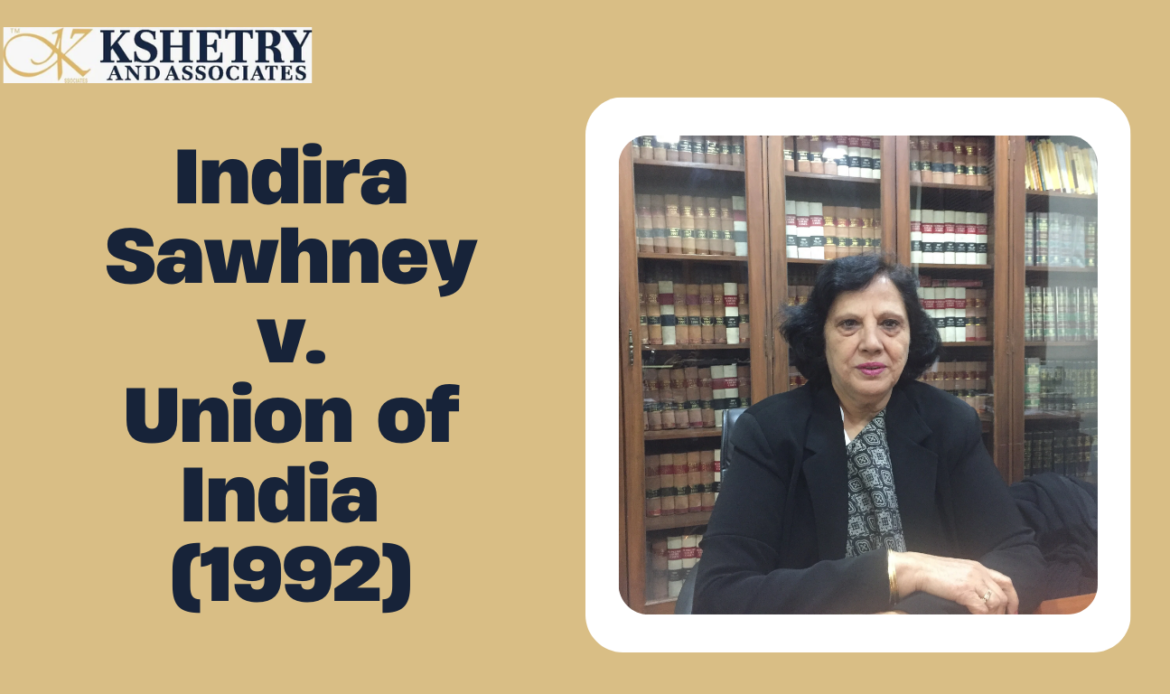The Indira Sawhney vs Union of India case, also known as the Mandal Commission case, stands as one of the most significant rulings in Indian constitutional history. It addressed a central issue: the reservation policy in public employment for the Other Backward Classes (OBCs), aimed at ensuring social justice and affirmative action for historically disadvantaged communities. The case not only upheld the constitutionality of reservations but also introduced significant safeguards to ensure that these provisions align with the broader constitutional mandate of equality.
Background
The genesis of the case lies in the recommendations of the Mandal Commission, which was established in 1979 to assess the conditions of socially and educationally backward classes in India. The Commission recommended a 27% reservation in government jobs and educational institutions for OBCs, in addition to the already existing quotas for Scheduled Castes (SCs) and Scheduled Tribes (STs). In 1990, then Prime Minister V.P. Singh announced the implementation of these recommendations, triggering widespread protests and legal challenges.
Key Issues
The case addressed several complex and contentious issues:
- Constitutionality of Reservations: Was the government’s decision to reserve 27% of public sector jobs for OBCs in line with the Constitution’s principles of equality (Article 14) and non-discrimination (Article 16)?
- Extent of Reservations: Could the total percentage of reservations exceed 50% of available jobs or educational seats?
- Creamy Layer Concept: Should wealthier and better-off members of the OBCs, often referred to as the ‘creamy layer,’ be excluded from the benefits of reservations?
- Judicial Review: To what extent could the judiciary review and intervene in the executive’s decision regarding reservations?
Judgment and the 50% Cap
The Supreme Court of India, in its 9-judge bench ruling, delivered a highly nuanced judgment on November 16, 1992. The Court upheld the constitutional validity of reservations for OBCs under Article 16(4) but laid down important guidelines to ensure that the system of affirmative action did not infringe upon the right to equality.
Key Findings of the Judgment:
1. Capping Reservations at 50%: The Court imposed a crucial restriction by capping reservations at 50%, meaning that no more than half of the total available jobs or seats could be reserved for SCs, STs, and OBCs. This cap was introduced to prevent excessive reservation, which could harm the rights of the general category and undermine meritocracy.
2. Exclusion of the Creamy Layer: A pivotal part of the judgment was the introduction of the concept of the ‘creamy layer’. The Court ruled that members of OBCs who were economically well-off and had access to better education and employment opportunities should be excluded from the benefits of reservation. This ensured that affirmative action was directed only towards those who truly needed it, preserving the essence of social justice.
3. Non-Retroactivity: The judgment also clarified that any decision or appointment already made under the previous reservation regime would not be undone by this ruling.
4. Judicial Review: While upholding the executive’s power to implement reservations, the Court maintained the right to judicial review of any reservation policy that appeared unreasonable or unconstitutional.
Significance
The Indira Sawhney judgment was a landmark in establishing a balanced approach between affirmative action and equality under the Constitution. It addressed the longstanding debate over reservations, ensuring that the benefits of such policies reached the most deserving, while protecting the rights of others.
The judgment had several far-reaching implications:
- Creation of a Balanced Reservation System: The decision to cap reservations at 50% struck a balance between the need for social upliftment of backward communities and the constitutional right to equality for all citizens.
- Introduction of the Creamy Layer Concept: This ensured that wealthier and more privileged sections of OBCs could not monopolize the benefits of reservations, allowing more disadvantaged members of the community to benefit.
- Constitutional Validity of Affirmative Action: By upholding the constitutionality of reservations, the Supreme Court reaffirmed the state’s responsibility to uplift socially and educationally backward classes while ensuring that these measures did not infringe upon individual rights.
Impact
The Indira Sawhney case continues to influence India’s reservation policies today. It has created a framework within which affirmative action programs can operate, ensuring that they are fair, just, and constitutional. The introduction of the creamy layer concept remains one of the most critical aspects of the ruling, ensuring that reservations are targeted towards those who need them most.
This case has also set a precedent for future legal battles regarding reservations, as seen in the subsequent challenges and discussions around quotas for economically weaker sections (EWS) and other underprivileged groups.
In conclusion, the Indira Sawhney vs Union of India judgment serves as a cornerstone in India’s legal framework for affirmative action, establishing critical checks and balances to ensure that reservations serve their intended purpose of social justice while safeguarding equality.
Visit Kshetry And Associates to gain knowledge about the landmark judgements in Indian legal history.

